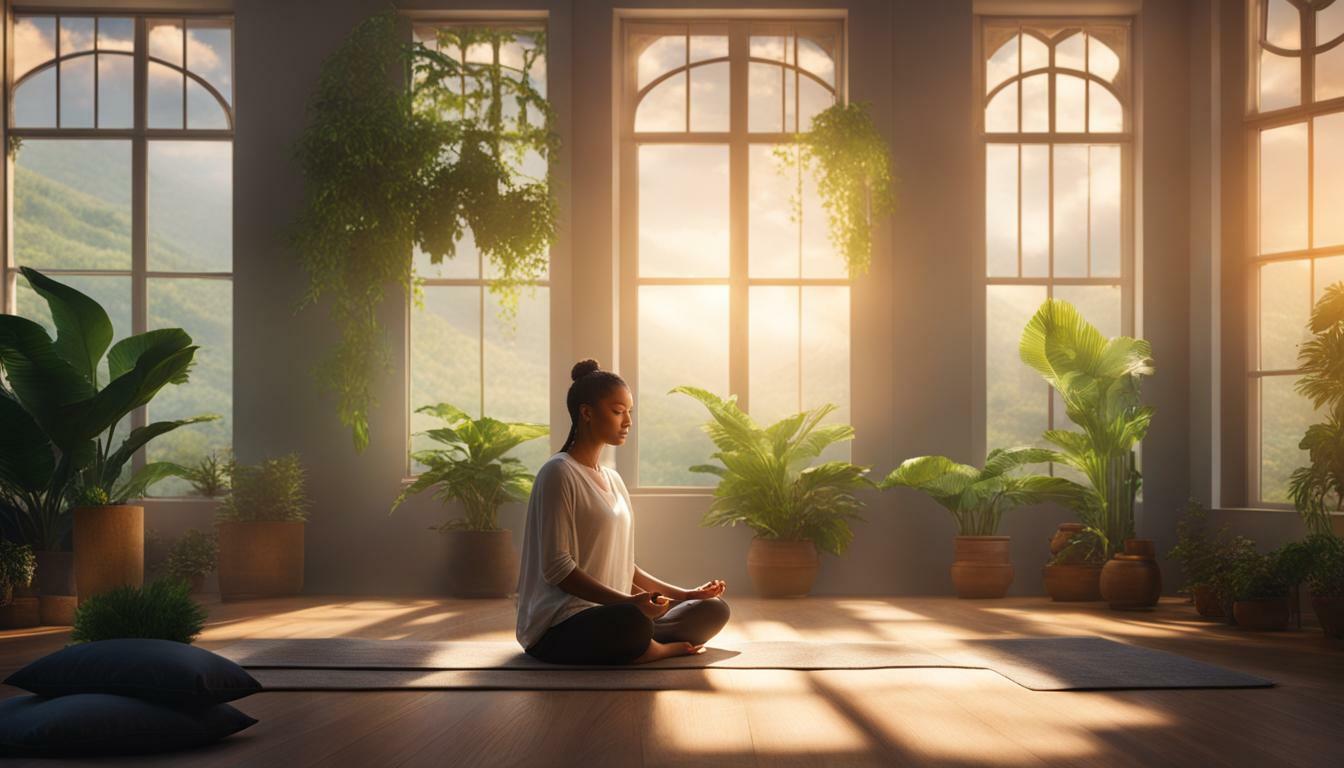Learning meditation at home is a convenient and effective way to reap the benefits of this ancient practice. To get started, it’s important to choose a meditation method that resonates with you and aligns with your goals, such as guided meditation, mindfulness meditation, or gratitude meditation. Begin with short, manageable sessions and gradually increase the duration over time. Find a quiet and comfortable spot in your home to meditate, and consider using a guided meditation app or course to provide structure and guidance. During meditation, focus on the present moment and use the breath as an anchor for your attention. It’s normal for the mind to wander, but simply acknowledge distractions and gently bring your focus back to the breath. With consistency and patience, meditation can bring about positive changes in stress levels, sleep quality, overall well-being, and even physical health.
Key Takeaways:
- Choose a meditation method that aligns with your goals and resonates with you.
- Start with short, manageable sessions and gradually increase the duration over time.
- Create a quiet and comfortable space in your home for meditation.
- Consider using guided meditation apps or courses for structure and guidance.
- Focus on the present moment and use the breath as an anchor for your attention.
Choosing the Right Meditation Method for You
To start your meditation journey at home, it is crucial to choose a meditation method that resonates with you. There are various techniques available, each offering unique benefits. Explore different options like guided meditation, mindfulness meditation, and gratitude meditation to find the one that aligns with your goals and preferences.
Guided meditation is a great choice for beginners as it provides structured guidance and support. With the help of audio or video recordings, you can follow along a meditation instructor’s voice and instructions, making it easier to stay focused and relaxed.
Mindfulness meditation is a popular technique that involves bringing your attention to the present moment and accepting it without judgment. By observing your thoughts, sensations, and emotions without getting caught up in them, you can cultivate a sense of calm and clarity.
Gratitude meditation centers around expressing gratitude for the present moment and the things in your life. This technique involves reflecting on the things you are thankful for, which can help shift your focus from stress and negativity to feelings of appreciation and contentment.
Choosing the Right Meditation Method for You
When deciding on a meditation method, consider your personal preferences, goals, and the outcome you hope to achieve. Experiment with different techniques to see what resonates with you the most. Remember, there is no one-size-fits-all approach, and it’s perfectly okay to try different methods until you find the one that suits you best.
| Guided Meditation | Mindfulness Meditation | Gratitude Meditation |
|---|---|---|
| Provides structure and guidance | Cultivates present moment awareness | Fosters feelings of appreciation |
| Helps beginners stay focused | Reduces stress and anxiety | Shifts focus from negativity to positivity |
| Available through apps and courses | Improves overall well-being | Encourages a positive mindset |
Remember, the journey of meditation is a personal one, and it may take time to find the meditation method that resonates with you. Be patient, explore different techniques, and trust that with consistency and practice, you will discover the path to inner peace and well-being.
Creating a Peaceful Environment for Meditation
Creating a peaceful environment in your home is essential for a successful meditation practice. It sets the stage for relaxation and allows you to fully immerse yourself in the present moment. Here are some tips to help you create a serene space:
- Find a quiet spot: Look for a corner or a room where you can retreat to without distractions. This could be your bedroom, a spare room, or even a cozy nook in your living room. Make sure it’s a space where you can feel comfortable and at ease.
- Set up comfortable seating: Choose a cushion, mat, or chair that provides adequate support for your body. Opt for a position that allows you to sit upright with a straight back, while still feeling relaxed and at ease. You want to find a balance between comfort and maintaining good posture.
- Incorporate calming elements: Enhance the atmosphere of your meditation space by adding elements that promote tranquility. Consider using soft lighting, scented candles, or soothing music to create a peaceful ambiance. You can also add plants or natural elements to bring a sense of grounding and connection with nature.
Remember, the goal is to create a space where you can feel calm and at peace. Experiment with different elements until you find what works best for you. This dedicated space will serve as a sanctuary for your meditation practice, allowing you to disconnect from the outside world and reconnect with yourself.
Pro tip: Remove distractions
“Distractions can disrupt your meditation practice, making it harder to focus and find inner stillness. Before you begin your session, silence your phone, close any open tabs on your computer, and let your household members know that you need some uninterrupted time. By eliminating external disturbances, you can fully immerse yourself in the present moment.”
By creating a peaceful environment, you set the stage for a deep and transformative meditation experience. Take the time to cultivate your meditation space, and you’ll find that it becomes an oasis of calm amidst the chaos of daily life.
| Meditation Space Checklist | Status |
|---|---|
| Quiet spot free from distractions | ✓ |
| Comfortable seating or cushion | ✓ |
| Soft lighting and calming elements | ✓ |
| Noise-canceling headphones (optional) | ✓ |
Establishing a Meditation Routine
Consistency is key when it comes to reaping the full benefits of meditation at home. By establishing a regular meditation routine, you can deepen your practice and make it a natural part of your daily life. Here are some tips to help you create a meditation routine that works for you:
- Set aside dedicated time: Schedule a specific time each day for your meditation practice. It can be in the morning before starting your day or in the evening before winding down. Find a time that works best for you and commit to it.
- Start with short sessions: If you’re new to meditation, begin with shorter sessions of just a few minutes. As you become more comfortable and focused, gradually increase the duration of your sessions.
- Find a quiet spot: Create a peaceful environment where you won’t be easily disturbed. Find a quiet corner in your home where you can sit comfortably and relax.
- Use a guided meditation app or course: If you find it challenging to meditate on your own, consider using a guided meditation app or course. These resources provide structure, guidance, and a variety of meditation techniques to explore.
Benefits of a Regular Meditation Routine
Establishing a regular meditation routine can bring about numerous benefits for your physical, mental, and emotional well-being. Here are some of the positive changes you may experience:
- Reduced stress and anxiety levels
- Improved focus and concentration
- Better sleep quality
- Enhanced self-awareness and mindfulness
- Increased feelings of calm and inner peace
Remember, meditation is a practice that requires patience and persistence. Be gentle with yourself and allow the process to unfold naturally. The journey towards inner peace and well-being begins with the commitment to a regular meditation routine.
| Meditation Tips | Benefits of Meditation |
|---|---|
| Set aside dedicated time each day for your meditation practice. | Reduced stress and anxiety levels |
| Start with shorter sessions and gradually increase the duration. | Improved focus and concentration |
| Create a peaceful and quiet environment for meditation. | Better sleep quality |
| Utilize guided meditation apps or courses for structure and guidance. | Enhanced self-awareness and mindfulness |
Using Guided Meditation Apps and Courses
Guided meditation apps and courses can be invaluable tools for beginners learning meditation at home. These resources provide structure, guidance, and a wealth of content to support your meditation journey. Whether you’re new to meditation or looking to deepen your practice, these apps and courses offer a convenient and accessible way to engage with this ancient technique.
One popular app is Mindfulness+, which offers a variety of guided meditations led by experienced teachers. From mindfulness exercises to stress reduction techniques, this app provides a range of options to suit your specific needs. Another option is Headspace, known for its user-friendly interface and step-by-step meditation programs. With carefully curated content and gentle guidance, Headspace makes it easy for beginners to start and maintain a meditation routine.
For those looking for a more personalized experience, Insight Timer is a great choice. This app boasts a vast library of meditations contributed by a global community of practitioners. With options for different meditation lengths, styles, and intentions, Insight Timer allows you to explore and discover what works best for you.
Benefits of Guided Meditation
- Structure: Guided meditations provide a clear framework, making it easier to stay focused and engaged. They offer step-by-step instructions, helping you develop a strong foundation in meditation techniques.
- Guidance: Experienced teachers guide you through the meditation process, offering insights and suggestions for deepening your practice. This personal guidance can be especially helpful for beginners navigating the challenges of meditation.
- Variety: Guided meditation apps and courses offer a wide range of content, allowing you to explore different styles and approaches. This variety helps you find what resonates with you and keeps your practice fresh and interesting.
- Flexibility: With guided meditation resources, you can practice anytime, anywhere. These apps and courses can be accessed from your smartphone or computer, giving you the flexibility to fit meditation into your daily routine.
By incorporating guided meditation apps and courses into your home practice, you can enhance your meditation experience and reap the numerous benefits it offers. Whether you’re seeking stress relief, better focus, or a sense of inner peace, these tools provide the support and structure you need to make meditation a regular part of your life.
| App/Course | Description |
|---|---|
| Mindfulness+ | Offers guided meditations led by experienced teachers, covering a variety of mindfulness exercises and stress reduction techniques. |
| Headspace | A user-friendly app with step-by-step meditation programs and curated content, suitable for beginners and those looking to deepen their practice. |
| Insight Timer | A community-driven app with a vast library of meditations contributed by practitioners worldwide. Allows for customization based on meditation length, style, and intention. |
Mastering the Basics of Meditation
To master meditation at home, it is important to understand and practice its basic principles. Learning to quiet the mind and find inner peace can be challenging, especially for beginners. However, with the right techniques and a little patience, you can make significant progress in your meditation practice.
One of the fundamental aspects of meditation is focusing on the present moment. This involves bringing your attention to the here and now, rather than getting caught up in thoughts about the past or worries about the future. To do this, you can start by simply observing your breath. Close your eyes, take a deep breath in, and slowly exhale. Notice the sensation of the breath entering and leaving your body. If your mind starts to wander, gently bring your attention back to your breath. This simple practice of mindfulness can help you cultivate a sense of awareness and presence in your daily life.
Dealing with distractions during meditation is normal, and it’s important not to get discouraged. When thoughts, sounds, or sensations arise, acknowledge them without judgment and let them pass by. Imagine them as clouds drifting across the sky of your mind. By letting go of attachment to these distractions, you can return to a state of calm and centeredness. Remember, meditation is not about achieving a blank mind, but rather developing a non-reactive awareness of your thoughts and feelings.
Consistency is key when it comes to meditation. Start with short, manageable sessions and gradually increase the duration over time. Aim for at least 5-10 minutes a day and gradually work your way up to 20-30 minutes. Setting aside dedicated time each day for meditation will help you establish a routine and make it a habit. You can also explore different types of meditation techniques, such as body scan meditation, loving-kindness meditation, or walking meditation, to find what resonates with you the most.
By incorporating these basic principles into your meditation practice, you can experience the stress-relieving benefits of meditation and cultivate a greater sense of peace and well-being in your life. Remember, meditation is a journey, and it takes time and practice to fully master. Be patient with yourself, and enjoy the process of deepening your meditation practice at home.
Conclusion
Start your meditation journey at home today and unlock the incredible benefits it has to offer. Learning meditation at home provides a convenient and effective way to experience the positive changes that this ancient practice can bring to your life. By choosing a meditation method that resonates with you, such as guided meditation or mindfulness meditation, you can begin to find inner peace and tranquility.
Creating a peaceful environment in your home for meditation is essential. Find a quiet and comfortable spot where you can relax and focus. Consider incorporating elements like soft lighting, calming scents, or soothing music to enhance your meditation experience. Using a guided meditation app or course can also provide structure and guidance, making it easier to establish a consistent meditation routine.
During your meditation sessions, remember to focus on the present moment and use your breath as an anchor for your attention. It’s normal for the mind to wander, but gently bring your focus back each time you notice distractions. With consistency and patience, meditation can bring about positive changes in your stress levels, sleep quality, overall well-being, and even physical health.
So, why wait? Start your meditation practice at home today and embrace the journey towards inner peace and well-being. Discover the incredible benefits that meditation can bring to your life, and experience the transformative power of this ancient practice.
Is Joe Dispenza Meditation a Good Method to Learn Meditation at Home?
Joe dispenza meditation techniques offer a powerful method to learn meditation at home. With his guidance, individuals can tap into their inner potential and create positive changes in their lives. By practicing Joe Dispenza’s meditation techniques regularly, one can experience enhanced focus, reduced stress, and improved overall well-being. It is a reliable path to self-discovery and personal growth.
FAQ
Q: How do I choose the right meditation method?
A: It’s important to choose a meditation method that resonates with you and aligns with your goals. Consider techniques such as guided meditation, mindfulness meditation, or gratitude meditation.
Q: Where should I meditate at home?
A: Find a quiet and comfortable spot in your home to meditate. Create a peaceful environment that allows you to focus and be free from distractions.
Q: How long should my meditation sessions be?
A: Begin with short, manageable sessions and gradually increase the duration over time. Find a length that works for you and allows you to deepen your practice.
Q: Can I use guided meditation apps or courses?
A: Absolutely! Guided meditation apps and courses can provide structure and guidance in your meditation practice. Explore popular platforms and find one that suits your needs.
Q: What should I focus on during meditation?
A: During meditation, focus on the present moment and use your breath as an anchor for your attention. Acknowledge distractions and gently bring your focus back to the breath.
Q: How long will it take to see results from meditation?
A: Results may vary, but with consistency and patience, meditation can bring about positive changes in your stress levels, sleep quality, overall well-being, and even physical health.








